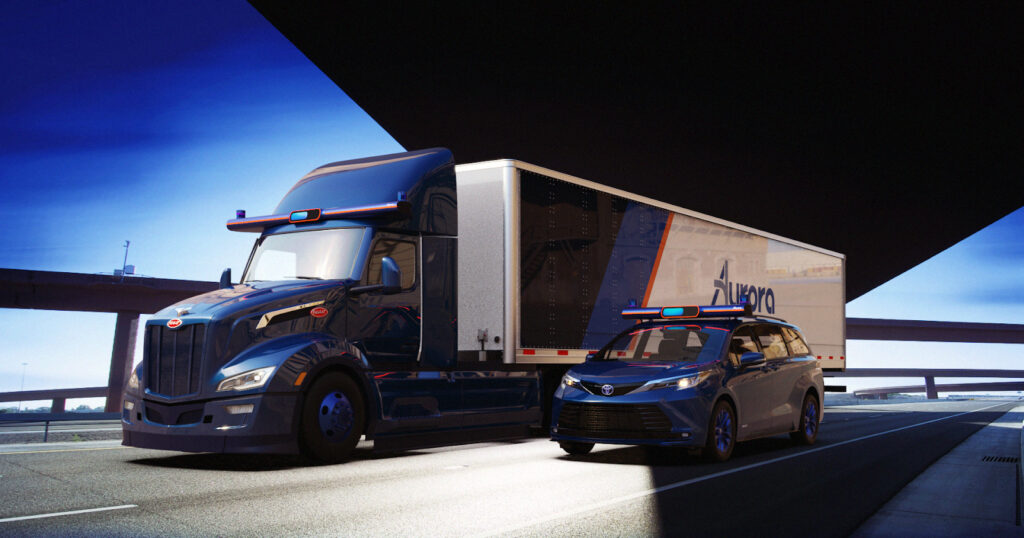Aurora Debuts Next-generation Commercial Hardware Designed for Wide-scale Deployment of the Aurora Driver
Aurora’s next-generation hardware is designed to operate all of Aurora’s vehicle platforms, including trucks, light-duty vans, and passenger cars
Aurora met a critical milestone in its path to commercialization by announcing the development of its next generation of hardware. Aurora’s next generation of hardware will debut in commercial pilots this year and lay the foundation for the launch of the company’s trucking and ride-hailing businesses in 2023 and 2024, respectively. With more powerful sensors condensed into a sleek, modular, automotive-grade rack and a new powerhouse computer, Aurora’s hardware is feature-complete and primed to deliver a safer, more reliable Aurora Driver at a commercial scale.
Whether it’s detecting a pedestrian over three football fields away, registering the speed of oncoming traffic, or driving through thick dust clouds and a blindingly bright sunset, the Aurora Driver has to see it all. It also has to know what to do with the world it sees. To handle the trickiest of edge cases, Aurora’s integrated hardware suite is made up of cameras, radar, and lidar sensors and designed to be much stronger than the sum of its parts.
“Aurora has years of collective industry experience in developing world-class hardware teams and products,” said Sandor Barna, SVP of Hardware at Aurora. “Aurora’s hardware fuses the best of many generations of hardware development from Aurora and Uber ATG into a single, optimized, deeply integrated system, setting us up for the successful deployment of the Aurora Driver.”
Powerful high-resolution custom camera suite with 360-degree field of view
Aurora’s hardware leadership team is unmatched when it comes to building cost-effective high-performance cameras and incorporating the latest top-of-the-line camera technology. Aurora’s hardware comes with new 360-degree cameras, which combine the most advanced automotive-grade sensor technology with custom-designed lenses. The cameras allow the Aurora Driver to detect objects even in challenging lighting situations like facing headlight glare and sun glare, and entering and exiting tunnels.
Proprietary lidar that instantly knows the speed of everything it sees
FirstLight Lidaraccurately measures the position and velocity of every point it observes to build a dynamic 3D representation of the world for the Aurora Driver. By leveraging FirstLight’s data, the Aurora Driver can track the velocity and compute the acceleration of vehicles over 400 meters away faster than ever before, creating more time for braking and responding safely. With the addition of OURS’ silicon photonics technology, Aurora has laid the groundwork to mass-manufacture lidar sensors at an even lower cost when the Aurora Driver is deployed at a commercial scale.
Radar that provides full coverage in any weather condition
Imaging radar is more precise than traditional radar, providing the Aurora Driver with high resolution and broad coverage that complements the data it receives from cameras and lidar. The improved imaging radar sensors on Aurora’s hardware produce true and precise 3D images despite challenging weather conditions like rain, dense fog, and snow.
A powerhouse computer that optimizes sensor inputs
Aurora’s hardware comes with a powerful, elegant machine with a 5x increase in processing power, built-in redundancy for additional safety, and the networking power capacity to operate safely without a safety driver.
A safer, more reliable, and cost-effective Aurora Driver
Aurora’s next-generation hardware is designed to operate all of Aurora’s vehicle platforms, including trucks, light-duty vans, and passenger cars. With sophisticated and cost-effective cameras, lidar, and radar, and a new powerhouse computer, Aurora’s new hardware gives the Aurora Driver the advanced range, field of view, data accuracy, and efficiency it needs to handle sun glare, bright emergency vehicle lights, dust, pedestrian detection at night, small object detection with high accuracy, fast-moving actors such as speeding motorcyclists, and more.
Before the launch of Aurora’s autonomous trucking and ride-hailing businesses, this feature-complete hardware will debut on Aurora’s Class 8 trucks in commercial pilots and on the company’s test fleet of Toyota Siennas that will hit public roads at the end of 2021.
Category: AUTONOMOUS, Connected Fleet News, Driver Stuff, Equipment, Featured, Fleet Diagnostics & Software, Fleet Tracking, General Update, News, Products, Safety, Tech Talk











